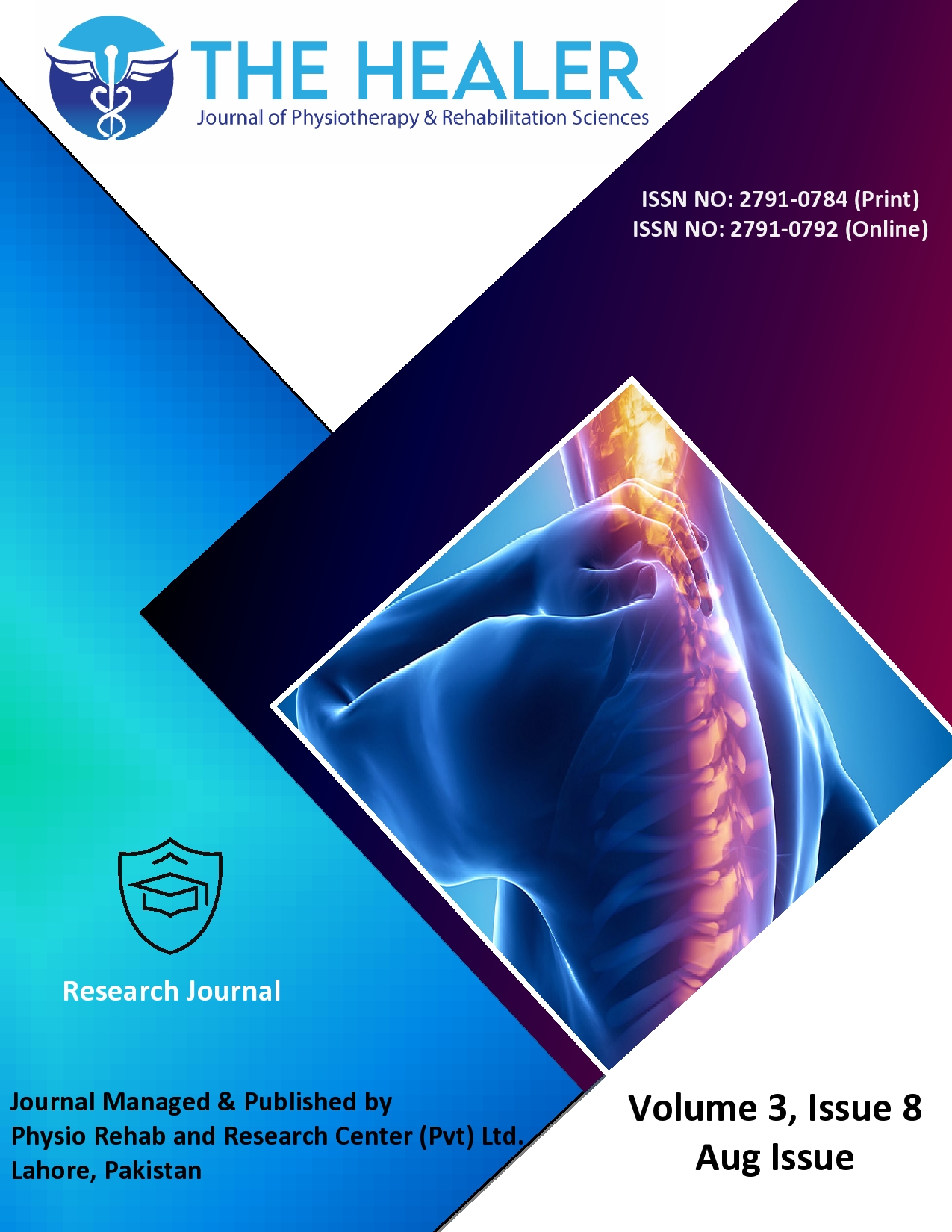Effects of Functional Strength Training Using Universal Exercise Unit on Spasticity of Lower Extremities Among Children with Cerebral Palsy; A Quasi-Experimental Study
Functional Strength Training in Cerebral Palsy
DOI:
https://doi.org/10.55735/hjprs.v3i8.157Keywords:
cerebral palsy, modified Ashworth scale, universal exercise unitAbstract
Background: Cerebral palsy is a non-reversible disorder of movement and posture. Its incidence is very high globally with 2 to 2.5 per 1000 live births. In Pakistan, spastic type of cerebral palsy is most common and major reason for disability among children. Objective: To find out the effects of functional strength training in a universal exercise unit on spasticity of lower extremities among children with cerebral palsy. Methods: A quasi-experimental study was conducted from July to December 2020 at Khawaja Arshad Hospital, Sargodha, Pakistan on 15 spastic diaplegic children with cerebral palsy that were collected by simple purposive sampling. A baseline measurement was done by using the Modified Ashworth Scale. Intervention includes two sessions of universal exercise unit on alternate days with functional strength training exercises in between. A specially designed treatment approach was given in the universal exercise unit for 8 consecutive weeks after that; post-treatment assessment was done. Data was analyzed by way of the usage of SPSS version 21 and Wilcoxon signed rank test was used. Results: The study comprised 15 participants, where 10 (66.6%) were male and 5(33.3%) were female. About 12 (80%) were of age <5 and 3(20%) years. In this study, the Modified Ashworth scale is used to assess any changes in the spasticity of children who were having treatment sessions in a universal exercise unit. The mean spasticity score was 3.4±0.5 and 1.46±0.99 pretest posttest respectively. In the results mentioned, there is a clinical significance of 0.001 that showed that there is a significant difference in spasticity pre and post-treatment. Results were taken by applying the Wilcoxon signed-rank test. Conclusion: Universal exercise unit has positive effects on lower extremity functional outcomes among children with cerebral palsy. It may decrease the spasticity of joints in the lower extremity so there is a need for more studies to be done.
References
Pham R, Mol BW, Gecz J, et al. Definition and diagnosis of cerebral palsy in genetic studies: a systematic review. Developmental Medicine & Child Neurology 2020; 62(9): 1024-30.
Palsi PÇS, İnceleme HT. Cerebral Palsy in Pakistani Children: A Hospital Based Survey. 2014.
Hamza RT, Ismail MA, Hamed AI. Growth hormone deficiency in children and adolescents with cerebral palsy: relation to gross motor function and degree of spasticity. Pakistan Journal of Biological Sciences 2011; 14(7): 433.
Mohammed AH, El-Serougy HR, Karim AEA, Sakr M, Sheha SM. Correlation between Selective Motor Control of the Lower Extremities and Balance in Spastic Hemiplegic Cerebral Palsy: a randomized controlled trial. BMC Sports Science, Medicine and Rehabilitation 2023; 15(1): 24.
Kumar D, Kumar R, Mudgal SK, Ranjan P, Kumar S. The Effects of Botulinum Toxin and Casting in Spastic Children With Cerebral Palsy: A Systematic Review and Meta-Analysis. Cureus 2023; 15(3).
Styer-Acevedo J, Tecklin J. Physical therapy for the child with cerebral palsy. Pediatric physical therapy 1999: 107-62.
Anttila H, Autti-Rämö I, Suoranta J, Mäkelä M, Malmivaara A. Effectiveness of physical therapy interventions for children with cerebral palsy: a systematic review. BMC pediatrics 2008; 8(1): 14.
Staudt LA, Peacock WJ. Selective posterior rhizotomy for treatment of spastic cerebral palsy. Pediatric Physical Therapy 1989; 1(1): 3-9.
Brit Sorsdahl A, Moe-Nilssen R, Larsen EM, et al. Long-term change of gross motor function in children with cerebral palsy; an observational study of repeated periods of intensive physiotherapy in a group setting. European Journal of Physiotherapy 2020; 22(3): 148-54.
Liaqat S, Butt MS, Javaid HMW. Effects of Universal Exercise Unit Therapy on Sitting Balance in Children with Spastic and Athetoid Cerebral Palsy: A Quasi-Experimental Study. Khyber Medical University Journal 2016; 8(4): 177-.
Alotaibi M, Long T, Kennedy E, Bavishi S. The efficacy of GMFM-88 and GMFM-66 to detect changes in gross motor function in children with cerebral palsy (CP): a literature review. Disability and rehabilitation 2014; 36(8): 617-27.
Ghotbi N, Ansari NN, Naghdi S, Hasson S. Measurement of lower-limb muscle spasticity: intrarater reliability of Modified Modified Ashworth Scale. J Rehabil Res Dev 2011; 48(1): 83-8.
Ansari NN, Naghdi S, Younesian P, Shayeghan M. Inter- and intrarater reliability of the Modified Modified Ashworth Scale in patients with knee extensor poststroke spasticity. Physiotherapy Theory and Practice 2008; 24(3): 205-13.
It TP. An Intensive Model of Therapy for a Child with Spastic Diplegia Cerebral Palsy: A Case Study.
Olama KA, Elnahhas AM, Rajab SH. Effect of universal exercise unit on balance in children with spastic Diplegia.
Tremblay F, Malouin F, Richards C, Dumas F. Effects of prolonged muscle stretch on reflex and voluntary muscle activations in children with spastic cerebral palsy. Scandinavian Journal of Rehabilitation Medicine 1990; 22(4): 171.
Damiano DL, Abel MF. Functional outcomes of strength training in spastic cerebral palsy. Archives of physical medicine and rehabilitation 1998; 79(2): 119-25.
Mohamed AS, Kamal HM, Elsied AO, Abd El-Gafar EM. Universal Exercise Unit versus Functional Resisted Training Effect on Muscle Strength in Spastic Diaplegia. Indian Journal of Public Health Research & Development 2020; 11(4): 1139-44.
Blundell S, Shepherd R, Dean C, Adams R, Cahill B. Functional strength training in cerebral palsy: a pilot study of a group circuit training class for children aged 4–8 years. Clinical rehabilitation 2003; 17(1): 48-57.
Gamit SB, Sutaria JM. Effect of Spider Therapy on Motor Functions and Balance in Cerebral Palsy-An Evidence Based Study.

Downloads
Published
How to Cite
License
Copyright (c) 2023 The Healer Journal of Physiotherapy and Rehabilitation Sciences

This work is licensed under a Creative Commons Attribution 4.0 International License.
CC BY


